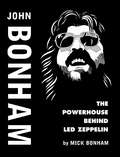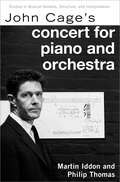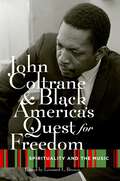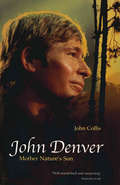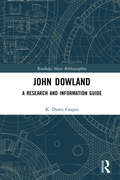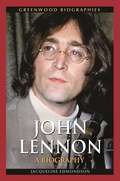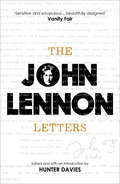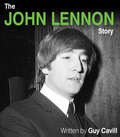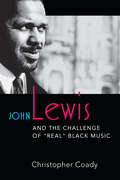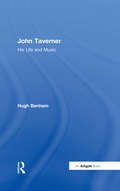- Table View
- List View
John Birchensha: Writings on Music
by Benjamin WardhaughJohn Birchensha (c.1605-?1681) is chiefly remembered for the impression that his theories about music made on the mathematicians, natural philosophers and virtuosi of the Royal Society in the 1660s and 1670s, and for inventing a system that he claimed would enable even those without practical experience of music to learn to compose in a short time by means of 'a few easy, certain, and perfect Rules'-his most famous composition pupil being Samuel Pepys in 1662. His great aim was to publish a treatise on music in its philosophical, mathematical and practical aspects (which would have included a definitive summary of his rules of composition), entitled Syntagma music Subscriptions for this book were invited in 1672-3, and it was due to be published by March 1675; but it never appeared, and no final manuscript of it survives. Consequently knowledge about his work has hitherto remained extremely sketchy. Recent research, however, has brought to light a number of manuscripts which allow us at last to form a more complete view of Birchensha's ideas. Almost none of this material has been previously published. The new items include an autograph treatise of c.1664 ('A Compendious Discourse of the Principles of the Practicall & Mathematicall Partes of Musick') which Birchensha presented to the natural philosopher Robert Boyle, and which covers concisely much of the ground that he intended to cover in Syntagma music a detailed synopsis for Syntagma music hich he prepared for a meeting of the Royal Society in February 1676; and an autograph notebook (now in Brussels) containing his six rules of composition with music examples, presumably written for a pupil. Bringing all this material together in a single volume will allow scholars to see how Birchensha's rules and theories developed over a period of fifteen years, and to gain at least a flavour of the lost Syntagma music
John Birchensha: Writings on Music
by Benjamin WardhaughJohn Birchensha (c.1605-?1681) is chiefly remembered for the impression that his theories about music made on the mathematicians, natural philosophers and virtuosi of the Royal Society in the 1660s and 1670s, and for inventing a system that he claimed would enable even those without practical experience of music to learn to compose in a short time by means of 'a few easy, certain, and perfect Rules'-his most famous composition pupil being Samuel Pepys in 1662. His great aim was to publish a treatise on music in its philosophical, mathematical and practical aspects (which would have included a definitive summary of his rules of composition), entitled Syntagma music Subscriptions for this book were invited in 1672-3, and it was due to be published by March 1675; but it never appeared, and no final manuscript of it survives. Consequently knowledge about his work has hitherto remained extremely sketchy. Recent research, however, has brought to light a number of manuscripts which allow us at last to form a more complete view of Birchensha's ideas. Almost none of this material has been previously published. The new items include an autograph treatise of c.1664 ('A Compendious Discourse of the Principles of the Practicall & Mathematicall Partes of Musick') which Birchensha presented to the natural philosopher Robert Boyle, and which covers concisely much of the ground that he intended to cover in Syntagma music a detailed synopsis for Syntagma music hich he prepared for a meeting of the Royal Society in February 1676; and an autograph notebook (now in Brussels) containing his six rules of composition with music examples, presumably written for a pupil. Bringing all this material together in a single volume will allow scholars to see how Birchensha's rules and theories developed over a period of fifteen years, and to gain at least a flavour of the lost Syntagma music
John Bonham: The Powerhouse behind Led Zeppelin
by Mick BonhamBonham is a complete portrait of the drummers' drummer written by his brother Mick Bonham. With exclusive interviews and previously un-published photos from the Bonham collection, as well as a complete Led Zeppelin chronology and history of Bonham's earlier musical career.
John Cage: A Research and Information Guide (Routledge Music Bibliographies)
by Sara HaefeliThis annotated bibliography uncovers the wealth of resources available on the life and music of John Cage, one of the most influential and fascinating composers of the twentieth-century. The guide will focus on documentary studies, archival resources, scholarly research, and autobiographical materials, and place the composer and his work in a larger context of postmodern philosophy, art and theater movements, and contemporary politics. It will support emerging scholarship and inquiry for future research on Cage, with carefully selected sources and useful annotations.
John Cage: A Research and Information Guide (Routledge Music Bibliographies)
by Sara HaefeliThis annotated bibliography uncovers the wealth of resources available on the life and music of John Cage, one of the most influential and fascinating composers of the twentieth-century. The guide will focus on documentary studies, archival resources, scholarly research, and autobiographical materials, and place the composer and his work in a larger context of postmodern philosophy, art and theater movements, and contemporary politics. It will support emerging scholarship and inquiry for future research on Cage, with carefully selected sources and useful annotations.
John Cage: Composed in America
by Marjorie Perloff Charles JunkermanWhen the great avant-gardist John Cage died, just short of his eightieth birthday in 1992, he was already the subject of dozens of interviews, memoirs, and discussions of his contribution to music, music theory, and performance practice. But Cage never thought of himself as only (or even primarily) a composer; he was a poet, a visual artist, a philosophical thinker, and an important cultural critic. John Cage: Composed in America is the first book-length work to address the "other" John Cage, a revisionist treatment of the way Cage himself has composed and been "composed" in America. Cage, as these original essays testify, is a contradictory figure. A disciple of Duchamp and Schoenberg, Satie and Joyce, he created compositions that undercut some of these artists' central principles and then attributed his own compositional theories to their "tradition." An American in the Emerson-Thoreau mold, he paradoxically won his biggest audience in Europe. A freewheeling, Californian artist, Cage was committed to a severe work ethic and a firm discipline, especially the discipline of Zen Buddhism. Following the text of Cage's lecture-poem "Overpopulation and Art," delivered at Stanford shortly before his death and published here for the first time, ten critics respond to the challenge of the complexity and contradiction exhibited in his varied work. In keeping with Cage's own interdisciplinarity, the critics approach that work from a variety of disciplines: philosophy (Daniel Herwitz, Gerald L. Bruns), biography and cultural history (Thomas S. Hines), game and chaos theory (N. Katherine Hayles), music culture (Jann Pasler), opera history (Herbert Lindenberger), literary and art criticism (Marjorie Perloff), cultural poetics (Gordana P. Crnkovic, Charles Junkerman), and poetic practice (Joan Retallack). But such labels are themselves confining: each of the essays sets up boundaries only to cross them at key points. The book thus represents, to use Cage's own phrase, a much needed "beginning with ideas."
John Cage's Concert for Piano and Orchestra (Studies in Musical Genesis, Structure, and Interpretation)
by Martin Iddon Philip ThomasJohn Cage's Concert for Piano and Orchestra is one of the seminal works of the second half of the twentieth century, and the centerpiece of the middle period of Cage's output. It is a culmination of Cage's work up to that point, incorporating notation techniques he had spent the past decade developing - techniques which remain radical to this day. But despite Cage's vitality to the musical development of the twentieth century, and the Concert's centrality to his career, the work is still rarely performed and even more rarely examined in detail. In this volume, Martin Iddon and Philip Thomas provide a rich and critical examination of this enormously significant piece, tracing its many contexts and influences - particularly Schoenberg, jazz, and Cage's own compositional practice - through a wide and previously untapped range of archival sources. Iddon and Thomas explain the Concert through a reading of its many histories, especially in performance - from the legendary performer disobedience and audience disorder of its 1958 New York premiere to a no less disastrous European premiere later the same year. They also highlight the importance of the piano soloist who premiered the piece, David Tudor, and its use alongside choreographer Merce Cunningham's Antic Meet. A careful examination of an apparently bewildering piece, the book explores the critical response to the Concert's performances, re-interrogates the mythology surrounding it, and finally turns to the music itself, in all its component parts, to see what it truly asks of performers and listeners.
John Cage's Concert for Piano and Orchestra (Studies in Musical Genesis, Structure, and Interpretation)
by Martin Iddon Philip ThomasJohn Cage's Concert for Piano and Orchestra is one of the seminal works of the second half of the twentieth century, and the centerpiece of the middle period of Cage's output. It is a culmination of Cage's work up to that point, incorporating notation techniques he had spent the past decade developing - techniques which remain radical to this day. But despite Cage's vitality to the musical development of the twentieth century, and the Concert's centrality to his career, the work is still rarely performed and even more rarely examined in detail. In this volume, Martin Iddon and Philip Thomas provide a rich and critical examination of this enormously significant piece, tracing its many contexts and influences - particularly Schoenberg, jazz, and Cage's own compositional practice - through a wide and previously untapped range of archival sources. Iddon and Thomas explain the Concert through a reading of its many histories, especially in performance - from the legendary performer disobedience and audience disorder of its 1958 New York premiere to a no less disastrous European premiere later the same year. They also highlight the importance of the piano soloist who premiered the piece, David Tudor, and its use alongside choreographer Merce Cunningham's Antic Meet. A careful examination of an apparently bewildering piece, the book explores the critical response to the Concert's performances, re-interrogates the mythology surrounding it, and finally turns to the music itself, in all its component parts, to see what it truly asks of performers and listeners.
John Coltrane and Black America's Quest for Freedom: Spirituality and the Music
by Leonard BrownEdited by prominent musician and scholar Leonard Brown, John Coltrane and Black America's Quest for Freedom: Spirituality and the Music is a timely exploration of Coltrane's sound and its spiritual qualities that are rooted in Black American music-culture and aspirations for freedom. A wide-ranging collection of essays and interviews featuring many of the most eminent figures in Black American music and jazz studies and performance --Tommy Lee Lott, Anthony Brown, Herman Gray, Emmett G. Price III, Tammy Kernodle, Salim Washington, Eric Jackson, TJ Anderson ,Yusef Lateef, Billy Taylor, Olly Wilson, George Russell, and a never before published interview with Elvin Jones -- the book examines the full spectrum of Coltrane's legacy. Each work approaches this theme from a different angle, in both historical and contemporary contexts, focusing on how Coltrane became a quintessential example of the universal and enduring qualities of Black American culture.
John Coltrane and Black America's Quest for Freedom: Spirituality and the Music
by Leonard L. BrownEdited by prominent musician and scholar Leonard Brown, John Coltrane and Black America's Quest for Freedom: Spirituality and the Music is a timely exploration of Coltrane's sound and its spiritual qualities that are rooted in Black American music-culture and aspirations for freedom. A wide-ranging collection of essays and interviews featuring many of the most eminent figures in Black American music and jazz studies and performance --Tommy Lee Lott, Anthony Brown, Herman Gray, Emmett G. Price III, Tammy Kernodle, Salim Washington, Eric Jackson, TJ Anderson ,Yusef Lateef, Billy Taylor, Olly Wilson, George Russell, and a never before published interview with Elvin Jones -- the book examines the full spectrum of Coltrane's legacy. Each work approaches this theme from a different angle, in both historical and contemporary contexts, focusing on how Coltrane became a quintessential example of the universal and enduring qualities of Black American culture.
John Denver: Mother Nature's Son
by John CollisJohn Denver was America's biggest-selling solo star of the '70s. In commercial terms he was on a par with Sinatra in the '40s, Elvis in the '50s and the Beatles in the '60s. He experimented with a variety of styles and won fans from such diverse worlds as folk, pop and country music. Beneath the often tranquil surface of his music and his clear, clean tenor voice, however, lurked a darker side to Denver's character. The writer of 'Annie's Song', one of the most straightforward and personal expressions of love, became a wife-beater. The man who cavorted with the Muppets was an alcoholic. The committed environmentalist had his own plane, the most polluting form of transport. John Collis has delved deep to discover exactly who John Denver was. By unravelling the complexities of the singer's personality and background, he reveals Denver as a complicated, contradictory man, much more intriguing than the sometimes placid surface of his music might suggest. Millions of people around the globe found something in his music that touched their souls; Collis, by charting Denver's career and development as an artist, explores his legendary contribution not only to the world of music but also to the society of which he was a protagonist and a victim.
John Dowland: A Research and Information Guide (Routledge Music Bibliographies)
by K. Dawn GrapesJohn Dowland: A Research and Information Guide offers the first comprehensive guide to the musical works and literature on one of the major composers of the English Renaissance. Including a catalog of works, discography of recordings, extensive annotated bibliography of secondary sources, and substantial indexes, this volume is a major reference tool for all those interested in Dowland's works and place in music history, and a valuable resource for researchers of Renaissance and English music.
John Dowland: A Research and Information Guide (Routledge Music Bibliographies)
by K. Dawn GrapesJohn Dowland: A Research and Information Guide offers the first comprehensive guide to the musical works and literature on one of the major composers of the English Renaissance. Including a catalog of works, discography of recordings, extensive annotated bibliography of secondary sources, and substantial indexes, this volume is a major reference tool for all those interested in Dowland's works and place in music history, and a valuable resource for researchers of Renaissance and English music.
John Farnham's Whispering Jack (33 1/3 Oceania)
by Graeme TurnerThe album examined in this book transformed the singer John Farnham from a faded teen pop star into the most popular solo rock performer in Australia, in a career that has lasted for more than 30 years. Whispering Jack remains the top-selling album by an Australian artist in Australia, and constitutes the turning point in Farnham's bid to achieve credibility as an adult contemporary musician. The first single from the album, 'You're the Voice,' has achieved such iconic status that it is routinely referred to as Australia's unofficial national anthem. The book examines the album, its context and that history in order to recover a crucial conjuncture in the development of Australian rock and popular music, one that has previously been ignored in Australian popular music studies.
John Farnham's Whispering Jack (33 1/3 Oceania)
by Graeme TurnerThe album examined in this book transformed the singer John Farnham from a faded teen pop star into the most popular solo rock performer in Australia, in a career that has lasted for more than 30 years. Whispering Jack remains the top-selling album by an Australian artist in Australia, and constitutes the turning point in Farnham's bid to achieve credibility as an adult contemporary musician. The first single from the album, 'You're the Voice,' has achieved such iconic status that it is routinely referred to as Australia's unofficial national anthem. The book examines the album, its context and that history in order to recover a crucial conjuncture in the development of Australian rock and popular music, one that has previously been ignored in Australian popular music studies.
John Fogerty: An American Son
by Thomas M. KittsThis is the first critical biography to explore John Fogerty's life and his music. When inducting Creedence Clearwater Revival into the Rock and Roll Hall of Fame in 1993, Bruce Springsteen referred to the "music’s power and its simplicity… [its] beauty and poetry and a sense of the darkness of events and of history, of an American tradition shot through with pride, fear, and paranoia." This book investigates those aspects and more of Fogerty’s songs and life: his Americanism, his determined individualism, and unyielding musical vision which led to conflicts with his band, isolation from his family, constant legal battles, and some of the greatest songs of the 20th century.
John Fogerty: An American Son
by Thomas M. KittsThis is the first critical biography to explore John Fogerty's life and his music. When inducting Creedence Clearwater Revival into the Rock and Roll Hall of Fame in 1993, Bruce Springsteen referred to the "music’s power and its simplicity… [its] beauty and poetry and a sense of the darkness of events and of history, of an American tradition shot through with pride, fear, and paranoia." This book investigates those aspects and more of Fogerty’s songs and life: his Americanism, his determined individualism, and unyielding musical vision which led to conflicts with his band, isolation from his family, constant legal battles, and some of the greatest songs of the 20th century.
John Lennon: A Biography (Greenwood Biographies)
by Jacqueline EdmondsonThis biography tells the complete story of John Lennon's life, including the controversial influence of his music, art, and philosophy upon the world.John Lennon was a singer, songwriter, activist, artist, and writer whose life and work left an indelible mark on rock music and the world. Lennon first became famous as the founding member of The Beatles, and his songwriting partnership with bandmate Paul McCartney remains legendary in the history of pop music. Lennon's creative work, which extended well beyond his years as a Beatle and lasted until his final days, still provides enjoyment and inspiration to millions around the world.This biography provides a comprehensive account of John Lennon's life for students and general readers, integrating information from interviews conducted during his life with published accounts of Lennon from a range of perspectives. It covers the time from his birth in Liverpool in 1940 to his murder in New York City in 1980.
John Lennon: A Biography (Greenwood Biographies)
by Jacqueline EdmondsonThis biography tells the complete story of John Lennon's life, including the controversial influence of his music, art, and philosophy upon the world.John Lennon was a singer, songwriter, activist, artist, and writer whose life and work left an indelible mark on rock music and the world. Lennon first became famous as the founding member of The Beatles, and his songwriting partnership with bandmate Paul McCartney remains legendary in the history of pop music. Lennon's creative work, which extended well beyond his years as a Beatle and lasted until his final days, still provides enjoyment and inspiration to millions around the world.This biography provides a comprehensive account of John Lennon's life for students and general readers, integrating information from interviews conducted during his life with published accounts of Lennon from a range of perspectives. It covers the time from his birth in Liverpool in 1940 to his murder in New York City in 1980.
The John Lennon Letters: Edited and with an Introduction by Hunter Davies
by Hunter Davies John LennonA lifetime of letters, collected for the first time, from the legendary The Beatles musician and songwriter John LennonJohn Lennon is one of the world's greatest-ever song writers, creator of 'Help!', 'Lucy in the Sky with Diamonds', 'Imagine' and dozens more. Now, his letters have been collected and published, illuminating as never before the intimate side of a private genius.Hunter Davies, author of the only authorised biography of The Beatles, has tracked down almost three hundred of Lennon's letters and postcards - to relations, friends, fans, strangers, lovers and even to the laundry. Some of the letters are tender, informative, funny, angry and abusive, and some are simply heart-breaking - from his earliest surviving thank-you note, written when he was ten, to his last scribbled autograph given on 8 December 1980, the day he was shot, aged forty.
John Lennon Story
by Guy CavillJohn Winston Ono Lennon, MBE (9th October 1940 - 8th December 1980) rose to world-wide fame as one of the founding members of the Beatles, and together with Paul McCartney formed one of the most successful song writing partnerships of the 20th century. Born and raised in Liverpool, Lennon became involved in the skiffle craze as a teenager with his first band. The Quarrymen, evolving into The Beatles in 1960. As the group began to undergo the disintegration that led to their break up towards the end of that decade, Lennon launched a solo career punctuated by critically acclaimed albums, including John Lennon/Plastic Ono Band and Imagine, and iconic songs such as "Give Peace a Chance" and "Imagine". Lennon revealed a rebellious nature and acerbic wit in his music, his writing, on film, and in interviews, and became controversial through his work as a peace activist. He moved to New York City in 1971, where his criticism of the Vietnam War resulted in a lengthy attempt by Richard Nixon's administration to deport him, while his songs were adapted as anthems by the anti-war movement. Disengaging himself from the music business in 1975 to devote time to his family, Lennon reemerged in 1980 with a comeback album, Double Fantasy, but was murdered three weeks after its release, outside his flat in the Dakota Building.
John Lewis and the Challenge of "Real" Black Music (Jazz Perspectives)
by Christopher CoadyFor critics and listeners, the reception of the 1950s jazz-classical hybrid Third Stream music has long been fraught. In John Lewis and the Challenge of “Real” Black Music, Christopher Coady explores the work of one of the form’s most vital practitioners, following Lewis from his role as an arranger for Miles Davis’s Birth of the Cool sessions to his leadership of the Modern Jazz Quartet, his tours of Europe, and his stewardship of the Lenox School of Jazz. Along the way Coady shows how Lewis’s fusion works helped shore up a failing jazz industry in the wake of the 1940s big band decline, forging a new sound grounded in middle-class African American musical traditions. By taking into account the sociocultural milieu of the 1950s, Coady provides a wider context for understanding the music Lewis wrote for the Modern Jazz Quartet and sets up new ways of thinking about Cool Jazz and Third Stream music more broadly.
John Prine's John Prine (33 1/3)
by Erin OsmonHe is known as the Mark Twain of American songwriting, a man who transformed the everyday happenings of regular people into plainly profound statements on war, industrialization, religion, and the human condition. Marking the 50th anniversary of the album's release, John Prine chronicles the legendary singer-songwriter's Middle American provenance, and his remarkable ascent from singing mailman to celebrated son of Chicago.“Illegal Smile,” “Hello in There,” “Sam Stone,” “Paradise,” “Your Flag Decal Won't Get You Into Heaven Anymore,” “Far from Me,” “Donald and Lydia,” and “Angel from Montgomery” are considered standards in the American Songbook, covered by legions of Prine's peers and admirers. Through original interviews, exhaustive research, and incisive commentary, author Erin Osmon paints an in-depth portrait of the people, places, and experiences that inspired Prine's landmark debut.After exploring his roots in rural Western Kentucky and suburban Maywood, Illinois, the book takes readers on an evocative journey through John Prine's Chicago. Its neighborhoods, characters, and clubs of the 1960s and 70s proved a formative and magical period in Prine's life, before he was a figurehead of the new Nashville scene. It's both a journalistic inquiry and a love letter: to Prine's self-titled debut and the Midwestern city that made him.
John Prine's John Prine (33 1/3)
by Erin OsmonHe is known as the Mark Twain of American songwriting, a man who transformed the everyday happenings of regular people into plainly profound statements on war, industrialization, religion, and the human condition. Marking the 50th anniversary of the album's release, John Prine chronicles the legendary singer-songwriter's Middle American provenance, and his remarkable ascent from singing mailman to celebrated son of Chicago.“Illegal Smile,” “Hello in There,” “Sam Stone,” “Paradise,” “Your Flag Decal Won't Get You Into Heaven Anymore,” “Far from Me,” “Donald and Lydia,” and “Angel from Montgomery” are considered standards in the American Songbook, covered by legions of Prine's peers and admirers. Through original interviews, exhaustive research, and incisive commentary, author Erin Osmon paints an in-depth portrait of the people, places, and experiences that inspired Prine's landmark debut.After exploring his roots in rural Western Kentucky and suburban Maywood, Illinois, the book takes readers on an evocative journey through John Prine's Chicago. Its neighborhoods, characters, and clubs of the 1960s and 70s proved a formative and magical period in Prine's life, before he was a figurehead of the new Nashville scene. It's both a journalistic inquiry and a love letter: to Prine's self-titled debut and the Midwestern city that made him.
John Taverner: His Life and Music
by Hugh BenhamJohn Taverner was the leading composer of church music under Henry VIII. His contributions to the mass and votive antiphon are varied, distinguished and sometimes innovative; he has left more important settings for the office than any of his predecessors, and even a little secular music survives. Hugh Benham, editor of Taverner‘s complete works for Early English Church Music, now provides the first full-length study of the composer for over twenty years. He places the music in context, with the help of biographical information, discussion of Taverner‘s place in society, and explanation of how each piece was used in the pre-Reformation church services. He investigates the musical language of Taverner‘s predecessors as background for a fresh examination and appraisal of the music in the course of which he traces similarities with the work of younger composers. Issues confronting the performer are considered, and the music is also approached from the listener‘s point of view, initially through close analytical inspection of the celebrated votive antiphon Gaude plurimum.

